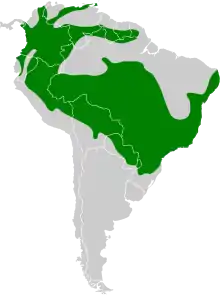Swallow tanager
The swallow tanager (Tersina viridis) is a species of Neotropic bird in the tanager family Thraupidae. It is the only member of the genus Tersina. It is found widely throughout South America, from eastern Panama to far northern Argentina. The species is sexually dimorphic: the female is a yellow-green and the male a turquoise blue with a small deep black face and upper throat patch.
| Swallow tanager | |
|---|---|
..jpg.webp) | |
| Female | |
 | |
| Male in Paraná, Brazil | |
| Scientific classification | |
| Kingdom: | Animalia |
| Phylum: | Chordata |
| Class: | Aves |
| Order: | Passeriformes |
| Family: | Thraupidae |
| Genus: | Tersina Vieillot, 1819 |
| Species: | T. viridis |
| Binomial name | |
| Tersina viridis (Illiger, 1811) | |
 | |
Taxonomy
The swallow tanager was formally described in 1811 by the German zoologist Johann Karl Wilhelm Illiger under the binomial name Hirundo viridis.[2] The type type locality is eastern Brazil.[3] The species is now the only member of the genus Tersina that was introduced in 1819 by the French ornithologist Louis Jean Pierre Vieillot.[4][5] The genus name is from the French Tersine, an unidentified bird described by Georges-Louis Leclerc, Comte de Buffon. The specific epithet viridis is the Latin for "green".[6] A molecular phylogenetic study of the tanager family published in 2014 found that the swallow tanager is sister to the honeycreepers in the genus Cyanerpes.[7]
Three subspecies are recognised:[5]
- T. v. grisescens Griscom, 1929 – north Colombia
- T. v. occidentalis (Sclater, PL, 1855) – east Panama and Colombia (except north) east to the Guianas and north Brazil and south to Bolivia (except southeast) and northwest Argentina
- T. v. viridis (Illiger, 1811) – east, south Brazil, southeast Bolivia, Paraguay and northeast Argentina
Description
The swallow tanager is 14.5–15 cm (5.7–5.9 in) in length with a broad flat bill. This bird is strongly sexually dimorphic. The male is bright turquoise blue with a back face and throat. The turquoise flanks have black barring and the lower belly is white. The female is bright green with dusky-olive barring on the flanks. She lacks the black face mask.[8] They are gregarious but do not associate with other species. They mainly eat fruit but they will also sally after insects from an exposed perch. The swallow tanagers are unique among tanagers in that they will sometimes dig a hole in a bank for a nest.[8]
References
- BirdLife International (2012). "Tersina viridis". IUCN Red List of Threatened Species. 2012. Retrieved 26 November 2013.CS1 maint: ref=harv (link)
- Illiger, Johann Karl Wilhelm (1811). Prodromus systematis mammalium et avium (in Latin). Berolini [Berlin]: :Sumptibus C. Salfeld. p. 229.
- Paynter, Raymond A. Jr, ed. (1970). Check-List of Birds of the World. Volume 13. Cambridge, Massachusetts: Museum of Comparative Zoology. p. 409.
- Vieillot, Louis Jean Pierre (1819). Nouveau dictionnaire d'histoire naturelle, appliquée aux arts, à l'agriculture, à l'économie rurale et domestique, à la médecine, etc (in French). Volume 33. Paris: Deterville. p. 401.
- Gill, Frank; Donsker, David; Rasmussen, Pamela, eds. (July 2020). "Tanagers and allies". IOC World Bird List Version 10.2. International Ornithologists' Union. Retrieved 23 October 2020.
- Jobling, James A. (2010). The Helm Dictionary of Scientific Bird Names. London: Christopher Helm. pp. 382, 403. ISBN 978-1-4081-2501-4.
- Burns, K.J.; Shultz, A.J.; Title, P.O.; Mason, N.A.; Barker, F.K.; Klicka, J.; Lanyon, S.M.; Lovette, I.J. (2014). "Phylogenetics and diversification of tanagers (Passeriformes: Thraupidae), the largest radiation of Neotropical songbirds". Molecular Phylogenetics and Evolution. 75: 41–77. doi:10.1016/j.ympev.2014.02.006.
- Ridgely, Robert S.; Tudor, Guy (2009). Birds of South America: Passerines. Helm Field Guides. London: Christopher Helm. p. 600. ISBN 978-1-408-11342-4.
External links
- Xeno-canto: audio recordings of the swallow tanager
- Swallow Tanager videos on the Internet Bird Collection
- Stamps (for Paraguay, Suriname, Venezuela) with RangeMap
- Swallow Tanager photo gallery VIREO
